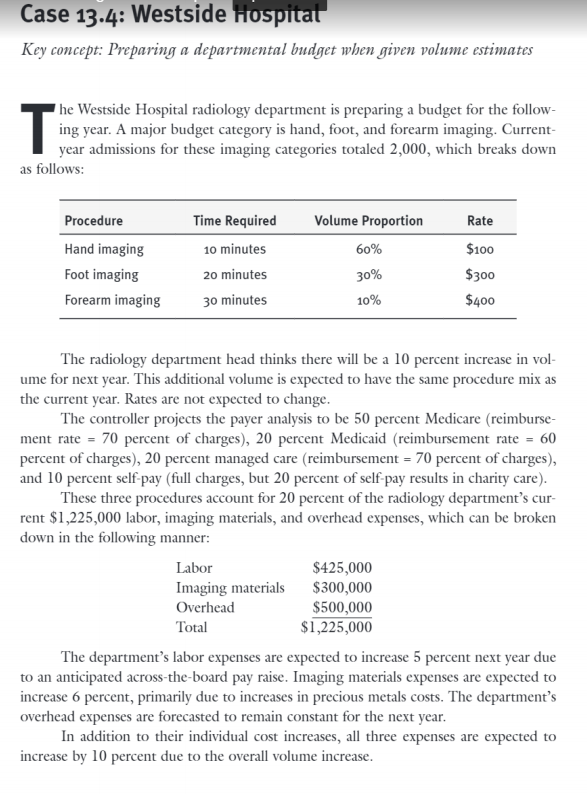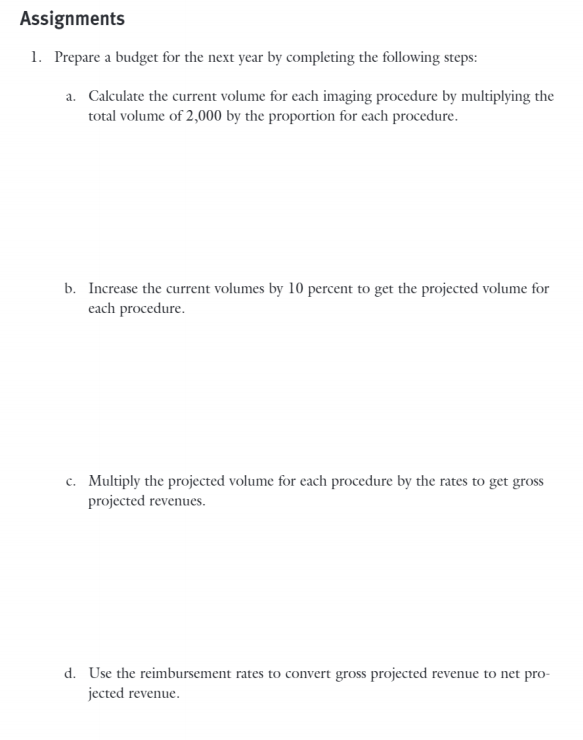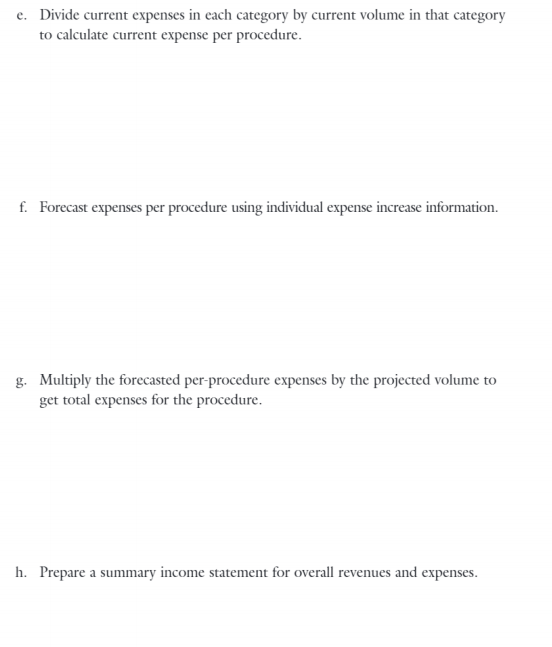



Case 13.4: Westside Hospital Key concept: Preparing a departmental budget when given volume estimates he Westside Hospital radiology department is preparing a budget for the follow- ing year. A major budget category is hand, foot, and forearm imaging. Current- year admissions for these imaging categories totaled 2,000, which breaks down as follows: Procedure Time Required Volume Proportion Rate 60% Hand imaging Foot imaging Forearm imaging 10 minutes 20 minutes 30 minutes 30% 10% $100 $300 $400 The radiology department head thinks there will be a 10 percent increase in vol- ume for next year. This additional volume is expected to have the same procedure mix as the current year. Rates are not expected to change. The controller projects the payer analysis to be 50 percent Medicare reimburse- ment rate = 70 percent of charges), 20 percent Medicaid (reimbursement rate = 60 percent of charges), 20 percent managed care reimbursement = 70 percent of charges), and 10 percent self-pay (full charges, but 20 percent of self-pay results in charity care). These three procedures account for 20 percent of the radiology department's cur- rent $1,225,000 labor, imaging materials, and overhead expenses, which can be broken down in the following manner: $425,000 Imaging materials $300,000 Overhead $500,000 Total $1,225,000 Labor The department's labor expenses are expected to increase 5 percent next year due to an anticipated across the board pay raise. Imaging materials expenses are expected to increase 6 percent, primarily due to increases in precious metals costs. The department's overhead expenses are forecasted to remain constant for the next year. In addition to their individual cost increases, all three expenses are expected to increase by 10 percent due to the overall volume increase. Assignments 1. Prepare a budget for the next year by completing the following steps: a. Calculate the current volume for each imaging procedure by multiplying the total volume of 2,000 by the proportion for each procedure. b. Increase the current volumes by 10 percent to get the projected volume for each procedure. c. Multiply the projected volume for each procedure by the rates to get gross projected revenues. d. Use the reimbursement rates to convert gross projected revenue to net pro- jected revenue. e. Divide current expenses in each category by current volume in that category to calculate current expense per procedure. f. Forecast expenses per procedure using individual expense increase information. g. Multiply the forecasted per-procedure expenses by the projected volume to get total expenses for the procedure. h. Prepare a summary income statement for overall revenues and expenses. 2. Assume time required per procedure is an appropriate RVU proxy, and calculate cost per RVU. Then use cost per RVU to calculate cost per procedure, compare this number to rate per procedure, and then comment on areas of the budget that might be of most concern to management. Case 13.4: Westside Hospital Key concept: Preparing a departmental budget when given volume estimates he Westside Hospital radiology department is preparing a budget for the follow- ing year. A major budget category is hand, foot, and forearm imaging. Current- year admissions for these imaging categories totaled 2,000, which breaks down as follows: Procedure Time Required Volume Proportion Rate 60% Hand imaging Foot imaging Forearm imaging 10 minutes 20 minutes 30 minutes 30% 10% $100 $300 $400 The radiology department head thinks there will be a 10 percent increase in vol- ume for next year. This additional volume is expected to have the same procedure mix as the current year. Rates are not expected to change. The controller projects the payer analysis to be 50 percent Medicare reimburse- ment rate = 70 percent of charges), 20 percent Medicaid (reimbursement rate = 60 percent of charges), 20 percent managed care reimbursement = 70 percent of charges), and 10 percent self-pay (full charges, but 20 percent of self-pay results in charity care). These three procedures account for 20 percent of the radiology department's cur- rent $1,225,000 labor, imaging materials, and overhead expenses, which can be broken down in the following manner: $425,000 Imaging materials $300,000 Overhead $500,000 Total $1,225,000 Labor The department's labor expenses are expected to increase 5 percent next year due to an anticipated across the board pay raise. Imaging materials expenses are expected to increase 6 percent, primarily due to increases in precious metals costs. The department's overhead expenses are forecasted to remain constant for the next year. In addition to their individual cost increases, all three expenses are expected to increase by 10 percent due to the overall volume increase. Assignments 1. Prepare a budget for the next year by completing the following steps: a. Calculate the current volume for each imaging procedure by multiplying the total volume of 2,000 by the proportion for each procedure. b. Increase the current volumes by 10 percent to get the projected volume for each procedure. c. Multiply the projected volume for each procedure by the rates to get gross projected revenues. d. Use the reimbursement rates to convert gross projected revenue to net pro- jected revenue. e. Divide current expenses in each category by current volume in that category to calculate current expense per procedure. f. Forecast expenses per procedure using individual expense increase information. g. Multiply the forecasted per-procedure expenses by the projected volume to get total expenses for the procedure. h. Prepare a summary income statement for overall revenues and expenses. 2. Assume time required per procedure is an appropriate RVU proxy, and calculate cost per RVU. Then use cost per RVU to calculate cost per procedure, compare this number to rate per procedure, and then comment on areas of the budget that might be of most concern to management










